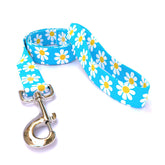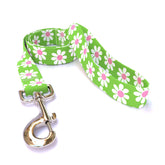How to leash train a puppy?

As the owner of a young puppy, you probably have a To Do list that includes things like potty training, basic obedience, and leash training. Teaching your puppy to walk beside you on a loose leash is an important skill, and fortunately it’s not that complex. Be consistent in following the straightforward steps below, and in time you’ll find yourself with a puppy who behaves well on the leash.
What Age is Best to Leash Train a Puppy?
You can start leash training your pup as early as 8 weeks, the age at which most puppies come home. But many people wait until the 10- or 12-week mark to start. The younger the puppy, the longer you can expect training to take, as everything is still so new and they have so much undirected energy.
If you start leash training your puppy and find that it’s a real struggle and you’re not making any progress after a few days, it’s okay to stop and pick it up again in a few weeks. Doing so could save you time and frustration.
Tools to Help You Leash Train Your Puppy
Leash
It goes without saying that the most important tool to help you leash train your puppy is the LEASH! Choose a non-retractable, 4- to 6-foot-long leash for leash training for the best control.
Collar
Arguably as important as the leash in leash training is the collar that goes with it. A standard buckle or snap collar works well for most puppies. Martingale collars, which are designed with two loops to reduce pressure on the trachea, are effective for puppies that can slip out of a standard collar or that strain a lot against their collar. They’re also the collar of choice for breeds with slim heads like greyhounds and whippets. Harnesses that clip in the front are an effective alternative to collars, too.
Avoid prong collars, choke collars, and slip collars at this time. These can be effective training tools for older dogs, but while puppies are still learning and haven’t yet made the connection between pain from the collar and bad behavior, these can just lead to injury without an improvement in behavior. Avoid harnesses that clip at the back and head collars (gentle leaders), too; again, these are great alternatives for older dogs but they simply don’t provide the same amount of control as the classic collar + leash combo that you need to leash train a puppy.
Browse our selection of 800+ collars and 1800+ leashes and 900+ dog harnesses at Hot Dog Collars to find the right combination for your puppy!
Treats
Giving your puppy treats they love when they’re walking well on the leash is an effective way to positively reinforce good behavior.
How to Leash Train a Puppy
The goal of leash training your puppy is to have them walk calmly on the leash, without straining, by your side and follow your cues for where to go and when to stop. You can train this behavior by rewarding your puppy whenever they’re doing something you like and by preventing or redirecting your puppy from doing something you don’t like.
Get your puppy used to the collar and leash
Before you ever step outside for a walk, make sure your puppy is comfortable with wearing the collar and having the leash attached to it. You might want to take a couple days just to let your puppy wear their collar and leash in the house (supervised, so the leash doesn’t get tangled up in anything) to get used to the sensation.
Reward good behavior
Start walking with your puppy. When they walk calmly by your side, reward this behavior with verbal praise (“good girl!” or “good walking!”) and a little treat. If your puppy is very young and energetic, this might not happen often at first. That’s okay. Just recognize and reward the good behavior when it does happen.
Deter bad behavior
When your puppy pulls at the leash, straining ahead to go faster or getting distracted by something to the side, simply stop walking. Wait until your puppy gets the message and stops straining. Only when they’ve stopped pulling and the leash is slack should you start walking again.
Keep leash training short and focused
This isn’t the time for exploring, greeting passers-by, or socializing with other dogs. You can do all those things later. Right now, work on teaching your puppy to act well on the leash.
And that’s basically it. It’s not complicated to leash train, but it requires consistency and persistence and patience. You could find that a “quick” walk around the block that should take 5 minutes could end up taking 20 with all the stopping you do. But it’s this consistency that will teach your puppy the difference between desirable and undesirable behavior.
How is Leash Training a Puppy Different from Leash Training a Dog?
The process of leash training your puppy is very similar to leash training your dog, but there are a few special considerations because of your puppy’s age.
Puppies are generally more distractible than older dogs. This can make leash training significantly more challenging, as they may want to explore every novel thing they encounter, which at just a few months old could be everything!
One way to combat this is to avoid new places when leash training your puppy. Practice leash training in your backyard or inside your home, or follow the same short route around your neighborhood every time. There will still be plenty of distractions, but a familiar location won’t be as amazingly exciting for your puppy as somewhere brand new.
Another tip is to walk briskly. When your puppy has to work to match your pace, they may be less likely to get distracted by what’s around them. They also be less likely to walk ahead of you and pull.
Also, puppies have shorter attention spans than older dogs. For that reason, as mentioned above, keep leash training sessions with your puppy short. Start with just 5-minute sessions and work your way up to 10 minutes or more as your puppy’s behavior and attention span improves. You always want to end training on a “win,” and that’s more likely to happen with a shorter training session.
Leash Training for Life
You know how to leash train a puppy, but maybe you’re asking yourself “Why?” Leash training your puppy is one of the most important things you can do as a new dog owner. Dogs and puppies that aren’t leash trained can pull and strain so hard on the leash that their collar causes injury to the neck or trachea. If they’re big and strong, they could pull so hard and so fast that they knock you down, or knock over a child or bystander before you’re able to get them under control. By teaching your puppy how to behave on a leash, you’re ensuring their safety, your safety, and the safety of people and dogs you encounter on your walks. Plus, walking well together is more pleasant for both of you, and helps reinforce the dog-owner bond. For all these reasons, make leash training your puppy a priority!




